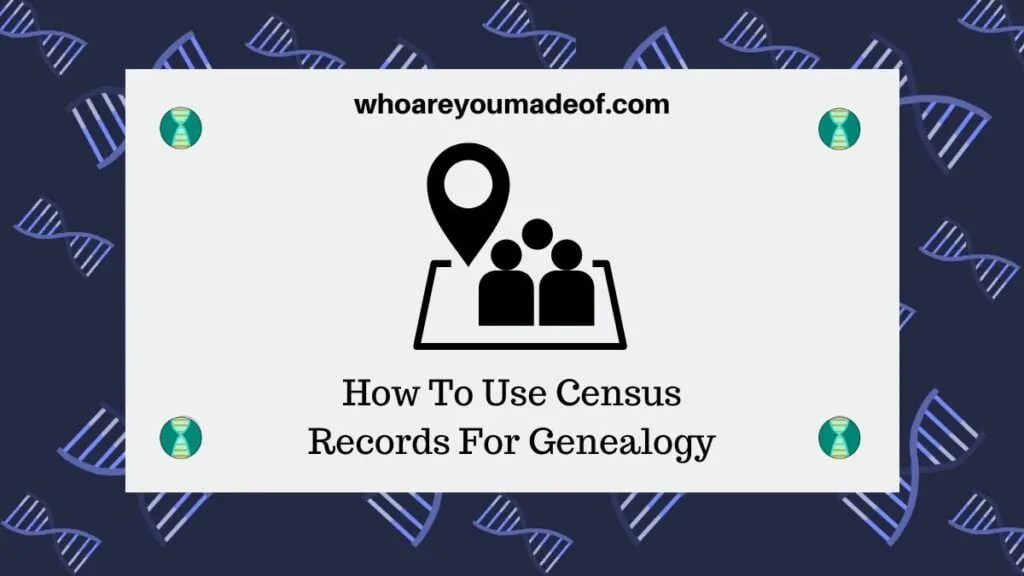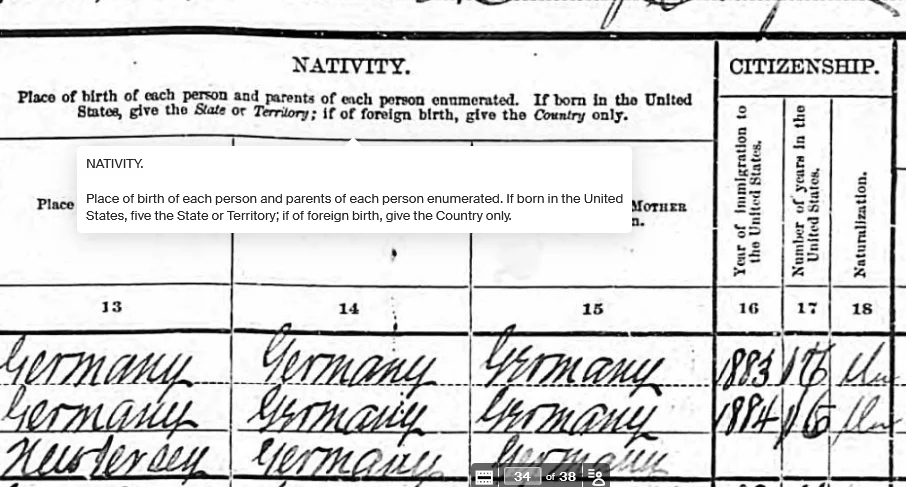Census records can be excellent sources for genealogy research. In this post, learn how you can use these records to learn about your ancestors.

Census records are some of my favorite types of genealogy records. This is because when you can locate your family's census records, they serve as a "snapshot" taken at regular intervals into their household and living situation.
This article primarily addresses US Federal Census records. The US Federal Census has been conducted every ten years since 1790, so it is a great way to track our families through time.
However, there are also census records from states and other countries around the world. A good example of very helpful, publicly available census records that are not from the US Federal Census are the from New Jersey State Census (1855-1915) and the 1930 Mexican National Census.
All of these census records can be viewed for free on Family Search.
What can you learn from census records?
The information that you can learn about your ancestor from census records depends on which census they responded to, since each census has slightly different questions. You may be able to learn their full name, address, their year and month of birth, whether they owned or rented their home, whether they served in the military, where they and their parents were born, what language they spoke, whether they were naturalized citizens, the year they immigrated, the names of everyone in their household, and more.
The specific questions asked on any given census form depend on what the government was trying to learn that year. For example, the 1790 Us Federal Census counted free white males over the age of 16 in order to estimate the country's military and labor force potential.
Census records are primary sources
Census records are especially valuable because they are primary sources created about your ancestor during his or her life. We have to put our observation and research skills to use to get the most from these primary sources because it is up to us to draw our own conclusions based on what we learn from the census records.
These conclusions, and new research ideas that come from what we see on the census records, can help us build our family tree.
How to use census records to build your family tree
The first step in using census records for genealogy or family tree research is to have a place to organize everything that you learn. This is most often in the form of a family tree, either using a software program on your computer, or on a website.
I like to use Ancestry to build my family tree because it's always free to build and store my family tree there. Here, I am able to build a profile with facts about each ancestor or relative in my tree, add photographs and attach source documents.
It is important to add everything to your family tree as you research census records, along with taking good notes. This way, you will be sure not to forget things that you learn and follow new research paths.
For example, I always save census forms to my family tree and attach them to each person in my tree who is mentioned in the record. This way, when I begin researching my ancestor again, I can easily view the census forms to quickly review what I already know about them.
Don't miss any details about your ancestor
Every single detail about your ancestor or their relative from a census form where they are listed can be an important clue about their life. This is why you should examine all of the fields on their line of the record.
I also recommend revisiting census forms periodically, since you might notice a new detail that you overlooked before.
Below, we'll discuss different pieces of information that you can learn from the census about your ancestor.
Their name
You will usually find your ancestor's first and last name, as well as a middle initial, on the census form. This is helpful because you may not have known that they used a middle name.
This information could help you identify additional records that pertain to them, such as birth or marriage records.
Occupation
Occupation is a helpful bit of data to find about our ancestor in the census. Most importantly, it helps us understand what type of work our ancestor was doing at that point in time to support their family.
However, it can also help us learn even more about our ancestor from places outside of the census records. For example, I have an ancestor with a relatively common name who was listed as being a barber at the age of 16.
By knowing that my ancestor was a barber, I can go through city directories and find his address throughout the late 1800s because I know which person by that name is my ancestor.
I was also able to confirm that my ancestor was the same person written about in a newspaper article in the Chicago Tribune. Otherwise, there would have been too few details in the article to help me understand for sure whether the subject of the article was my ancestor or someone with the same name.
Address
The address of our ancestor can usually be found on the census form, with the street name sometimes being written to the left of the form vertically from bottom to top, and the street number being marked in the designated field to the left of the name of the head of household.

The census taker who interviewed residents in Irvington, New Jersey in the 1900 census didn't write down the house number in the designated field, but they did note that these families lived on Orange Avenue.
Immigration details
Some census records contained questions about immigration status and year of immigration. These questions were added in the later half of the 1800s, when government officials began to notice an increase in immigration from certain countries.

In the image above, we find that the top two people were born in Germany, that they have been in the US for 16-17 years, and that their naturalization status is unknown.
Language
On census records after 1860, you might be able to find the language that your ancestor spoke listed on their line in the census record. This information can be helpful to us, especially if we don't know where our ancestor was from.
Place of birth of your ancestor and their parents
Take careful note of where your ancestor was reported to having been born. This can help you formulate a research strategy for finding additional records, such as travel and birth records.
Some census forms included questions about where parents were born, and this can provide additional clues about where our ancestors came from.
Locate the family in census records from each decade
Once you have identified your family in the census record, and have made a note of everything you can learn from that record, it's time to see if you can find them in the census that occurred 10 years before or 10 years after.
You should be able to identify your family in additional census records because you know the names and ages of most of their household members based on the census that you already located.
This is a good way to see whether your ancestors moved, where they went, and whether they had more children or other family members come to live with them.
If you are looking for a census record from 10 years prior to the one that you already found, be sure to consider that one of the parents from your ancestor's household may have been living with their parents at that time. So, you might be looking for a different household entirely.
Make a note of every person listed in the household
When we examine a census record, we should add all of the household members to our family tree. We might find new siblings, parents, or even grandparents to our ancestors on these records.
On each line of the form, pay close attention to how the census taker has recorded each person's relationship to the head of household. This can help you understand if any of the children are step-children or grandchildren, if the head-of-household's parents or mother or father-in-law is living with them at the time of the census.
If you find a surprising person, such as a cousin or grandchild, on the record, this is an opportunity to research them to see if you can discover who their parents were and how they ended up living with this family.
Parents and in-laws are a nice discovery on census records because they can help take us back another generation in our family tree. In the image below, we note that Charles is the head of household, and Mary, aged 68 in 1880, is listed as the mother-in-law.

With the knowledge of Wanda's mother's full name, I was then able to begin researching a full generation back in the family tree, eventually finding her mother's marriage record in Poland.
Don't ignore people who appear unrelated to the household
Sometimes a census record will mention a household member that is unknown to me, and reviewing these forms often reminds me that I need to spend some time trying to figure out who they are and whether they are related to the family.
In the image below taken from the 1910 census, we find the last two entries for a household in Chicago. Carrie Berg is the mother-in-law of the head of household, and John Lende is listed as a border.

However, since we can also see that they are both from Norway, and I know that the wife of the head of household is also from Norway (from the previous page of the census), we should explore the idea that their families may have known each other in Norway.
By researching John, even though I am not sure if he is related to the household in the census, I might discover that he is a cousin. Or, I could find out that they are all from the same Norwegian town.
Don't forget to check the page before and the next page
If you find your ancestor's family in the census, be sure to check the page immediately before and immediately after. This is especially important if your ancestor is listed at the top or very bottom of the census page.
You might find that there are additional family members listed before or after your ancestor's entry. You may also notice that there is a family with the same name as your ancestor living right next door, which could be a new research path.
What if something on the census seems wrong?
While census records are an amazing source of information, they are not always accurate. Occasionally, you can find errors on the census.
The census taker may have made a mistake or an incorrect assumption. Other times, the person who reported the information didn't remember the information correctly, made a guess as to the answer, or, less commonly, intentionally said something that wasn't true.
Conclusion
I hope that this post has helped you learn all that you need to know to get started using census records for learning about your ancestors.
If you have any questions about something that you read in this post, or if you want to share a story about something interesting you learned from a census record, please feel free to join in the discussion below.
Thanks for stopping by today!
